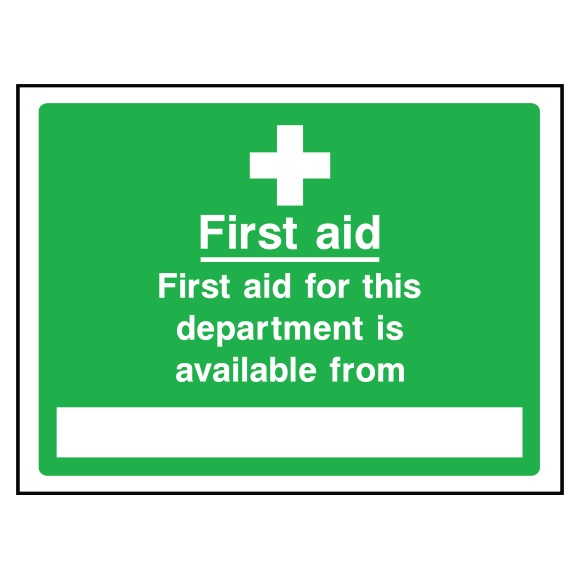
Emergencies can occur at any moment, and in public spaces, a swift response can be the difference between a minor incident and a serious outcome. Clear visual cues are essential in guiding people to immediate assistance, and first aider signs are among the most important tools in this process. From offices and schools to shopping centres and transport hubs, effective signage ensures that anyone in need can quickly locate trained personnel or first aid resources. Visual symbols serve as a universal language, overcoming literacy, language, and stress barriers.
This blog examines the importance of visual symbols for first aid, features of an effective first aider sign, placement strategies, and the benefits of durable materials like foamex for public signage.
Why Visual Symbols Are Critical in First Aid Response
When an emergency occurs, people often experience stress and panic, making it difficult to think clearly. During such moments, universally recognisable symbols can provide instant guidance, directing attention to first aid points, defibrillators, or trained personnel. A simple green cross, heart symbol, or other standardised icon can bridge the gap between confusion and prompt action, ensuring help is accessible immediately.
First aider sign act as a beacon for anyone seeking assistance. By clearly indicating the presence of trained staff or first aid equipment, these signs reduce response times and improve the likelihood of a positive outcome.
For ease of understanding, consider a simple table of common first aid symbols:
| Symbol | Meaning | Typical Location |
| Green cross | First aid point | Entrances, corridors |
| Heart | Defibrillator | Public spaces, sports centres |
| White cross on green | Emergency kit | Offices, classrooms, reception areas |
These symbols are designed for instant recognition. In emergencies, they eliminate the need for reading lengthy instructions, enabling anyone to act quickly and efficiently.
Key Features of an Effective First Aider Sign
A well-designed first aider sign must be clear, visible, and instantly understandable. Several design elements contribute to its effectiveness:
- Colour Contrast: High contrast between the background and symbols enhances readability. Green and white remain the standard colours for first aid signs, as they are easily distinguishable.
- Size and Scale: Signs should be large enough to be visible from a distance, helping people locate assistance without hesitation.
- Pictograms and Text: Simple symbols, complemented by concise text, improve comprehension for a wide audience.
- Compliance: UK health and safety regulations outline specific requirements for first aid signage. Ensuring compliance not only meets legal obligations but also maximises safety.
Durability is equally important. Signs must withstand environmental factors like sunlight, humidity, and potential wear and tear. This is where foamex comes in. Foamex is a lightweight, durable material that allows for high-quality printing of vibrant graphics and symbols. Its versatility makes it suitable for both indoor and sheltered outdoor environments, ensuring that signs remain clear and legible for years.
Strategic Placement of Visual Symbols
Even the most well-designed first aider sign is ineffective if it is not positioned correctly. Strategic placement ensures that signs are visible when and where they are needed most. Key considerations include:
- High-Traffic Areas: Place signs in locations where people naturally pass, such as entrances, corridors, and waiting areas.
- Consistent Placement: Uniformity across a site avoids confusion and helps people memorise locations.
- Eye-Level Visibility: Positioning signs at eye level increases the likelihood that they will be seen quickly.
- Unobstructed Views: Signs should never be hidden behind furniture, plants, or other obstacles.
- Accessibility: Ensure signs are visible and readable for all individuals, including those with disabilities.
Some practical placement tips include:
- At building entrances and exits
- Along main corridors and stairwells
- Near first aid kits and defibrillators
- In staff rooms, reception areas, and public spaces
By carefully considering placement, organisations can create an environment where first aid resources are easy to locate, reducing response times and improving safety for everyone.

Materials and Production of First Aider Signs
Choosing the right material is critical for ensuring that first aider signs remain visible, durable, and effective. Common materials include acrylic, PVC, aluminium, and foamex, each with its benefits.
Foamex is particularly popular for indoor and sheltered outdoor signs. Its advantages include:
- Lightweight: Easy to handle and mount without requiring heavy-duty fixings.
- Durable: Resistant to bending, warping, and moisture, ensuring longevity.
- High-Quality Printing: Supports vibrant colours and sharp graphics for clear, professional signage.
- Cost-Effective: Provides excellent value compared to other materials, without compromising quality.
Printing methods for foamex signs include UV printing, digital printing, and vinyl overlays, all of which enhance clarity and durability. Whether the signs are intended for indoor hallways, reception areas, or outdoor walkways, foamex offers a flexible and reliable solution for creating attention-grabbing and long-lasting first aid signage.
Enhancing Awareness and Training
While clear signage is essential, it works best when combined with staff awareness and training. Employees and regular users of public spaces should be familiar with the locations of first aid points and understand the meaning of standardised symbols.
Regular awareness campaigns, simple instructional signage, and staff orientation programmes contribute to a culture of safety. Even subtle digital enhancements, such as QR codes linking to first aid instructions, can complement physical first aider signs. This integrated approach ensures that in an emergency, people know exactly where to go and what to do.
Conclusion
Fast and effective first aid response relies on visibility, clarity, and strategic planning. Visual symbols, particularly well-designed first aider signs, guide people to help in moments of need, improving safety across public spaces. Choosing durable and high-quality materials such as foamex ensures that these signs remain clear, professional, and reliable over time.
Investing in proper signage, combined with staff awareness and accessible placement, can significantly reduce emergency response times and enhance public safety. For organisations seeking reliable, durable, and highly visible foamex first aider signs, Foamex Printing Company offers tailored solutions designed to keep everyone safe and supported when it matters most.
